Telangana SCERT TS 8th Class Physics Study Material Pdf 10th Lesson Some Natural Phenomena Textbook Questions and Answers.
TS 8th Class Physics 10th Lesson Questions and Answers – Some Natural Phenomena
Reflections on concepts
Question 1.
Describe with the help of a diagram an instrument which can be used to detect a charged body.
Answer:
The instrument used to detect the presence of charge on a body is called an ‘electroscope’.
Construction of an ‘electroscope’:
- An empty jam bottle is taken.
- A piece of cardboard is taken and used to cover the bottle (lid).
- A hole is pierced at the centre of the cardboard lid.
- A metal paper clip is taken and opened as appears in the diagram.
- Two strips of aluminium foil about 4 cm X cm each are cut. They are hung from the paper clip.
- The paper clip with the aluminium foils is inserted into the cardboard lid, so that the clip is perpendicular to the cardboard.
- The bottle is now closed with this lid. The electroscope is now ready.
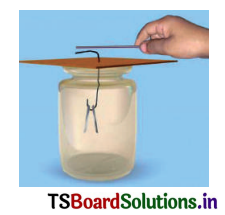
Question 2.
Which places are not safe during a thunderstorm?
Answer:
- Travelling in an open place.
- Standing under tall trees in open fields or in a garden/park.
- Staying in a multi-storied building which do not have lightning conductors.
- Standing near electric poles or telephone poles.
- Speaking in landline telephone.
- Using electric appliances like T.V and Computers.
Question 3.
List three states in india where earthquakes are more likely to occur.
Answer:
- Kashmir
- Rajasthan
- Gujarat
Question 4.
Explain how do you determine the intensity of Earthquake.
Answer:
- The intensity of an earthquake is expressed in terms of a magnitude on Richter scale.
- Richter scale is not a linear scale. It is a logarithmic scale.
- For example, the earthquake of magnitude 6 on Richter scale has thousand times more destructive energy than an earthquake of magnitude 4 on the same scale (and not simply, one and a haff times the destructive energy of an earthquake of magnitude 4).
Question 5.
Suppose you are outside your home and an earthquake occurs. What precautions would you take to protect yourself?
Answer:
Precautions:
- I try to reach a clear spot, away from buildings, trees and overhead power lines. Then I drop to the ground.
- If I happen to be in a car or a bus, I would not come out. I will ask the driver to drive slowly to the nearest clear spot. I will not come out till the tremors stop.
Application of concepts
Question 1.
Sometimes, a crackling sound is heard while taking off sweater during winter. Explain.
Answer:
During the process of taking off sweater rubbing takes place between our body and the fibres of the sweater. Static charges develop on the sweater as well as on our body. These are opposite charges. In presence of moisture (winter), which is an electrical conductor, discharge takes place between the two opposite charges. Then sparks as well as sounds are produced.
Question 2.
Give two examples of your daily life about effects which are caused by transfer of charges.
Answer:
‘Transfer of charge’ takes place at least in two instances. They are:
1. during lightning and
2. during earthing
- During lightning, we should not speak with a landline telephone. It may give a fatal electric shock.
- While meddling with any electrical installation in our house, if by chance, we happen to touch a live wire, immediately we experience a fatal electric shock. This is due to the ‘earthing’ of the electricity.
Question 3.
Inflate two balloons and rub both of them with a cloth first and then with different material. Will they attract each other in both cases?
Answer:
- In both the cases, the balloons acquire the same type of charge.
- Since ‘like charges repel’, the balloons repel each other, in both the cases.
Question 4.
Explain why a charged balloon is repelled by another charged balloon whereas an uncharged balloon is attracted by a charged balloon?
Answer:
A) A charged balloon is repelled by another charged balloon.
Reason: The same type of electric charge is present on both the balloons. We know, “like charges repel each other.’ So the two balloons with like charges on them, repel each other.
B) An uncharged balloon is attracted by a charged balloon.
Reason: We know, life a charged body is brought nearer to an uncharged body, an equal and opposite charge appears on that body.” This process is called, ‘induction’.
In the present case, when the uncharged balloon is brought nearer the charged balloon, an equal and opposite charge is induced on that balloon. We know, ‘unlike charges attract each other’. So now, the two balloons carrying opposite charges, attract each other. The underlying principle in this activity is that ‘induction precedes attraction’.
Question 5.
How do you appreciate the efforts of scientists in developing an instrument to measure the intensity and detect the source of earthquake?
Answer:
- An earthquake can not he predicted. It is a destructive natural phenomenon.
- An earthquake causes a great loss to life and property. It can also cause floods, landslides and tsunamis.
- Scientists developed an instrument to assess the intensity and source of earthquake. It is called a ‘seismograph’.
- The instrument records seismic waves. Seismic waves are the waves produced on the surface of the earth, due to earthquakes.
- From a study of these seismic waves, scientists construct a complete map of the earthquake. They also estimate its power to cause destruction.
- By studying this map, we locate the places prone to earthquakes. Then we can take necessary precautions to protect ourselves all the time.
- People living in seismic zones, where the earthquakes are more likely to occur, have to he specially prepared.
Seismograph:
Construction and working:
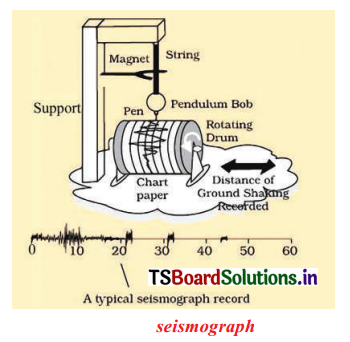
The instrument is simply a vibrating rod, or a pendulum, which starts vibrating when tremors occur. A pen is attached to the vibrating system. The pen records the seismic waves on a paper which moves under it. Scientists study these seismic waves and arrive at some conclusions.
Higher Order Thinking Questions
Question 1.
The weather department has predicted that a thunderstorm is likely to occur on a certain day. Suppose you have to go out on that day. Would you carry an umbrella’?
Explain.
Answer:
- When the weather department has predicated that a thunderstorm is likely to occur on certain day, It is not advised to go out holding the umbrella with your hand and keep it our your head.
- Then reason for that the natural rod of umbrella which we are holding will work as a lightning conductor.
- Due to the friction between the clouds, electrical discharge the surplus charge goes to the earth.
Eg: Suppose if the cloud is having totally positive charge electrons reach that cloud from earth to neutralize the charge. If the cloud is having totally negative charge it directly flows to the earth. In this process when you hold the umbrella the charge passes through the rod at the centre and the person who is holding the umbrella to earth.
Question 2.
Is there any alternative method to find the intensity of earthquakes?
Answer:
There is another method of measuring the intensity of earthquakes other than seismography.
Using the moment magnitude scale which is based on the amount of displacement that occurred along a fault zone rather than measurement of ground motion at a given point.
The moment magnitude measures energy released by the earthquake more accurately than Richter scale. It is the only magnitude scale that adequately measures the size of large earthquakes.
Question 3.
We know that the clouds have charges. Can we produce current through these charges’?
Answer:
Yes, we can produce current through these charges only problem is we cannot store that produced current anywhere since it goes down to the earth. When charged cloud comes close to another cloud it induces an opposite charge on the later and accumulated charge tries to move from one cloud te another cloud. But the air present between them being a poor conductor of electricity. resists the flow of charge between them.
When the magnitude of the accumulated charge becomes very large, the air, which is normally a poor conductor of electricity, is no longer able to resists their flow. Hence discharge takes place between negative and positive charges which produces streaks of bright light and sound. This process is called an electric discharge. This can occur between two or more clouds, or between cloud sthe earth.
Question 4.
How do you appreciate the efforts of the scientists to develop a lightening conductor to protect buildings from the effect of lightning.
Answer:
- A lightning conductor is a device used to protect buildings from the effect of lightning.
- A metallic rod, taller than the building, is installed in the walls of the building during its construction.
- One end of the rod is kept out in the air and the other is buried deep in the ground.
- The rod provides an easy route for the transfer of electric charge to the ground.
- The projected end of the metal rod is at a height more than the height of the building. Hence it receives the charge first during lightning because it is closer to the cloud than the building.
- As it is a good conductor of electricity it allows all the charge to flow through it thereby causing no damage to the building.
Multiple Choice Questions
Question 1.
Which of the following cannot be charged easily by friction [ ]
a) a plastic scale
b) a copper rod
c) a wollen cloth
d) piece of wood
Answer:
b) a copper rod
Question 2.
When a glass rod is rubbed with a piece of silk cloth [ ]
a) Rod and the cloth acquire positive charge
b) Road becomes positively charged while the cloth has a negative charge
c) Rod and the cloth both acquire negative charge
d) Rod becomes negatively charged while the cloth has a positive charge
Answer:
b) Road becomes positively charged while the cloth has a negative charge
Question 3.
The magnitude of destructive earthquakes on the Richter scale is greater than: [ ]
a) 3.0
b) 4.0
c) 7.0
d) 2.0
Answer:
c) 7.0
Question 4.
The instrument is used to estimate the intensity of earthquake is [ ]
a) Seismograph
b) Sesimoscope
c) Gold leaf electroscope
d) Lightning conductors
Answer:
a) Seismograph
Question 5.
it can protects buildings from the effects of lightning [ ]
a) Seismograph
b) Sesimoscope
c) Gold leaf electroscope
d) Lightning conductors
Answer:
d) Lightning conductors
Suggested Experiments
Question 1.
Conduct an experiment to find the effects of charged bodies which have been rubbed by different materials.
Answer:
Aim: To find effects of charged bodies which have been rubbed by different materials.
Material required: A ball pen refill, a balloon, a comb, an eraser, a steel spoon, polythene sheet, plain paper, woollen cloth etc.
Procedure: Let us rub the above objects against different materials and bring the rubbed object near to small pieces of paper and note whether they’ attract pieces of paper or not. Let us record your observation on table by writing ‘yes’ or ‘no’.
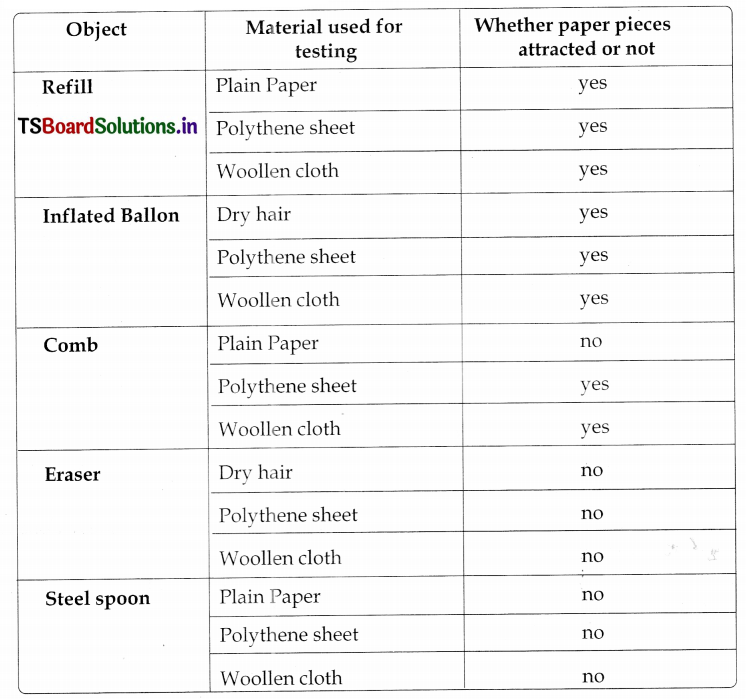
We conclude from the above table.
- Some objects like refill, comb, etc., when rubbed with some specific materials are able to attract light objects like pieces of paper.
- But some objects like spoon and eraser do not attract pieces of paper even after rubbing.
Question 2.
Conduct an experiment to find out the presence of charge on a body.
Answer:
- Let us make a small ball of thermaocol sheet.
- Collect thin silver foil used to decorate sweets.
- Wrap this thin silver toil to cover the thermaocol ball and suspend it from a stand with the help of a thread, as shown in the figure.
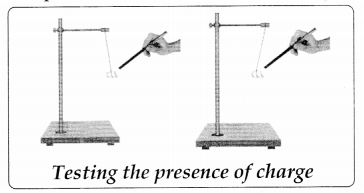
- Bring a glass rod which is rubbed with a silk cloth near to the suspended ball.
- Now touch the charged glass rod with silver foil on the therrnocol ball, Remove the glass rod form the ball and again rub it with silk cloth and bring it close to the suspended ball.
- In the first instance, the thermaocol ball attracted towards the glass rod and in the second instance it moved away from the glass rod
- In the above experiment, when a charged hod’ (glass rod rubbed with silk cloth) is brought near to an uncharged bod (thermaocol ball wrapped with silver foil), it induces an opposite charge on it and hence the ball got attracted by the glass rod.
- In the second case, we charged the thermaocol ball by touching it with a charged glass rod. Then the thermal ball gets simillar charge as the one present on the glass rod.
- When we bring the charged glass rod near to the ball, as both of them have similar charges the rod repels the ball.
Suggested Project Works
Question 1.
Which country in the world is most effected by earth quakes in recent past? Collect the information and photographs on the recent earthquakes.
Answer:
Japan
2011 Japan Earthquake and Tsunami:
Earthquakes and tsunamis are among the most frightening natural phenomena. If a severe earthquake or tsunami occurs in a densely populated area, it can practically swallow the city. This is what recently happened in Japan.
On March 11, 2011, an 8.9 magnitude earthquake hit off the east coast of Japan, followed b a disastrous tsunami. It was the largest ever earthquake in areas of the Japan’s recorded history. F-louses, cars and much else were washed away by high tsunami waves. There has been a massive power failure in many areas of the country.
Japanese officials confirmed that radioactive materials have leaked into the atmosphere, following a fire at reactor number 4 at the Fukushima power plant. Here are some of the images from Japan after the ferocious tsunami and earthquake hit, causing many injuries, fires and massive disasters.
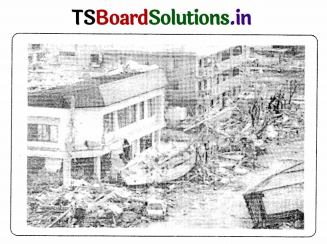
A fishing boat is noticeably out of place after being swept ashore during the massive tsunami.
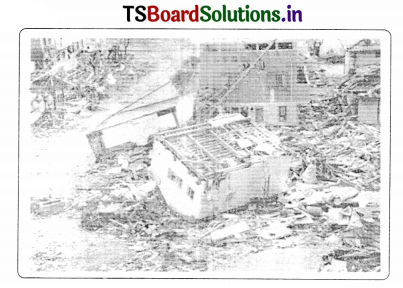
Question 2.
Find out if there is an organisation in your area which provides relief to those suffering from natural disaster. Enquire about the type of help they render to the victims of earthquakes. Prepare a brief report on the problems of the earthquake victims.
Answer:
Our state is less prone to earthquakes. However, cyclones cause natural disasters.
- In our area Red Cross Society, RSS and other charitable societies provide relief in natural disasters.
- They render different services like providing shelter, clothing and medicinal help.
- Earthquake victims generally face the problems of health hazards, damaged houses, crop damages, poor sanitation, lack of drinking facility and unhygienic conditions.
Question 3.
Collect accounts of the devastation caused by tsunami in India from your parents, friends and neighbourhood and write a report.
Answer:
- Tsunami occurred as recently as on 26th December 2004, in the Islands of Sumatra – Andaman.
- Extremely large tidal waves developed in north Indian Ocean and Bay of Bengal.
- When they hit the shores, incendated large chunks of the off-shore lands.
- There was a huge loss of life and property.
- In our Andhra Pradesh alone at least 105 persons were killed.
TS 8th Class Physics 10th Lesson Some Natural Phenomena Activities
Activity – 1 :
Effect of rubbing (Text. P. No. 133)
Question 1.
Explain an activity to show the effect of charging by rubbing.
Answer:
- Take a comb and bring it near to small pieces of paper.
- The comb should be close enough but not touch the pieces of paper.
- The paper pieces do not get attracted by the comb.
- Now move the comb through dry hair for few times and take the comb. near to small pieces of paper.
- Now pieces of papers are attracted toward the comb.
- From this we conclude when comb rubbed with hair (move through dry hair) it acquires a small electric charge.
- So “Charging by Rubbing” is the true statement.
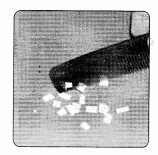
Do the charging by rubbing activity with refill, comb, drinking straw and balloon etc. Record Your observation in the table
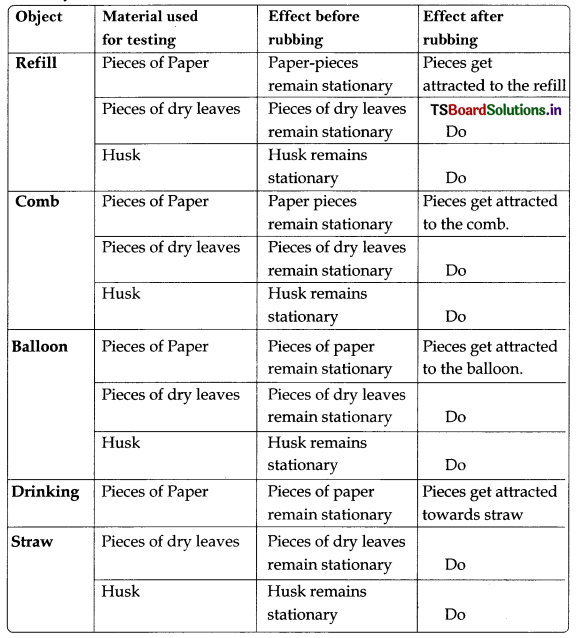
Question-based on the above activity Charging by Rubbing’ (Text. P. No. 133)
Take an inflated balloon and rub it against your clothes. Bring the balloon close to small pieces of paper.
Take a drinking straw and rub it against a smooth wall or against your clothes, then bring it near to pieces of paper.
a. What do you observe?
b. Are they able to attract pieces of paper after being rubbed?
Answer:
Pieces of paper are attracted to rubbed balloons and rubbed straws.
c. What can we infer from the above activity?
Answer:
From the activity, we infer certain things Charging by Rubbing.
- Due to rubbing, the body acquires charge.
- This charged body can attract pieces of paper, husk, etc.
Reason: The charged body first induces an equal and opposite charge un the other material, brought very nearer to it.
Then it attracts it. (Opposite charges attract each other)
d. Do the objects like refill or comb attract pieces of paper only after rubbing?
Answer:
Yes,
- When the refill or the comb is rubbed, it acquires a charge.
- After acquiring a charge (+ve or -ve), it can attract pieces of paper. pieces of dry leaves, husk, etc (Opposite charges attract each other)
e. Do all objects show the property of attracting pieces of paper after rubbing?
Answer:
Objects which can be charged by friction only show this property. (During friction, charged particles transfer from one body to the other).
f. Can we rub a comb against our palm and make it attract pieces of paper?
Answer:
- No.
- At any point of time our palm will not be dry. So it is not possible to charge a comb by rubbing against our palm.
- So the comb without an electric charge. can not attract pieces of paper.
Activity -2: Understanding woes of changes (Text. P. No. 135)
Question 2.
Describe an activity to show that like charges repel each other and unlike charges attract each other.
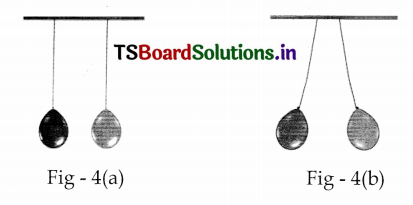
Answer:
- Inflate two balloons and hang them in such a way that they do not touch each other. Rub both the balloons with a woollen cloth and release them.
- You observe that one balloon repelled another balloon.
- Take a refill and rub it with polythene sheet. Keep it gently in a plastic tumbler.
- Take another refill and rub it also with polythene sheet.
- Bring the second refill near to the first one in the tumbler.
- You observe that the refills repell each other.
- Now take a rubbed balloon near the rubbed refill in tumbler and check the action.
- They attract each other.
- Both the balloons possess similar charge.
- Both the refills possess similar charge
- They possess different charges.
Take a refill and rub it with polythene sheet. Keep it gently in a plasbc tumbler. Take another refill and rub it also with polythene sheet. Bring the second refill near to the first one in the tumbler. Take care so that you do not touch either of the rubbed portions of the refills with your hand.
Question-based on the above Activity- 2
a. What do you observe?
Answer:
A balloon repelled another balloon.
b. Is there any effect on the refill in the tumbler?
Answer:
Yes.
c. Do they attract each other, or repel each other?
Answer:
They repel each other.
Take a rubbed balloon near the rubbed refill in tumbler and check the action.
d. Do they attract each other or repel each other?
Answer:
They attract each other.
- A balloon rubbed with woollen cloth repelled another balloon of the same type. (Page No: 136)
- A refill rubbed with polythene repelled another refill rubbed with similar material.
- A charged balloon was attracted by a charged refill.
a. What can we conclude from these observations? (Text. P. No. 136)
Answer:
- Both the baLloons possess similar charge.
- Both the refills possess similar charge
- Balloon and refill possess different charges.
b. Does the repulsion between charged balloons indicate that they posses similar charge?
Answer:
Yes. Both the balloons possess similar charge.
c. Does the attraction between a charged balloon and a charged refill Indicate that they posses different charges? (Text P. No. 136)
Answer:
Yes. They possess different (opposite) charges.
d. Does this activity remind you some of experiments that you have done in playing with ‘Magnets chapter of class VII? (Text. P. No. 136)
Answer:
- Yes.
- A magnet has two poles a south pole and a north pole.
- In case of magnets also, just like in case of electric charges, ‘like poles repel each other and ‘unlike poles attract each other’.
ii.
- A balloon rubbed with woollen cloth repelled another balloon of the same tyqe.
- A refill rubbed with polythene repelled another refill rubbed with similar material.
- A charged balloon attracted by a charged refills.
a. Can we say that something similar to is happening In above activities the principle “unlike poles of magnets (North-South or South-North) attract each other and like poles (North- North or South-South) repel each other. (Text. P. No. 136)
Answer:
- Yes.
- “The charges of the same kind repel each other, while charges of different kind attract each other”.
b. Does it indicate that the charge on the balloon is of a different kind from the charge on the refill? (Text. P. No. 236)
Answer:
- Yes.
- The charges are not of the same kind. They are opposite charges.
c. Can we say that there exists two kinds of charges? (Text P. No. 136)
Answer:
Yes. There exist two kinds of charges.
d. Can we also say that the charges of the same kind repel each other, while charges of different kinds attract each other? (Text. P. No. 136)
Answer:
- Yes.
- Charges of the same kind repel each other,while charges of different kinds attract each other.
It is observed that when a charged glass rod is brought near to a charged plastic straw which is rubbed with polythene sheet, there is attraction between the two.
e. What do you think about the kind of charge on the plastic straw? (Text. P. No. 136)
Answer:
Plastic straw carries a -ve charge. You may guess that the plastic straw would carry a negative charge.
f. Is your guess correct or wrong? Discuss with your teacher. (Text. P. No. 136)
Answer:
1) It is correct.
Reasons :
- Glass rod rubbed with silk cloth: Glass rod acquires a ve charge.
- Plastic straw rubbed with polythene sheet or fur: Plastic straw acquires a – ve charge. So the charged glass rod and charged plastic straw, attract each other.
Activity – 3: To find the presence of charge on a body (Text. P. No. 137)
Question 3.
To find the presence of charge on a body
Answer:
- Make a small ball of thermocol sheet.
- Collect thin silver roil used to decorate sweets,
- Wrap this thin silver foil to cover the thermocol ball and suspend it from a stand with the help of a thread, as shown in the figure.

- Bring a glass rod which is rubbed with a silk cloth near to the suspended hail.
- Now touch the charged glass rod with silver foil on the thermocol ball. Remove the glass rod form the ball and again rub it with silk cloth and bring it close to the suspended ball.
- In the first instance, the thermocol ball attracted towards the glass rod and in the second instance it moved away from the glass rod.
- In the above experiment, when a charged body (glass rod rubbed with silk cloth) is brought near to an uncharged body (thermocol ball wrapped with silver foil), it induces an opposite charge on it and hence the ball got attracted by the glass rod.
- In the second case, we charged the thermoset ball by touching it with a charged
glass rod. Then the thermocouple ball gets simular charge as the one present on the glass rod. - When we bring the charged glass rod near to the Ml, as both of theni have similar charges the rod repels the ball.
Questions based on the above Activity -3
a. What do you observe? Does It get attracted towards glass the rod or move away from it?
Answer:
then thermocol hail attracted towards the glass rod ad An the set instance it moved away from the glass rod.
b. What could be the reason for this change in movement of the ball?
Answer:
- In the above experiment, when a charged body (glass rod rubbed with silk cloth) is brought near to an uncharged body (thermocol ball wrapped with silver foil), it induces an opposite charge on it and hence the ball got attracted by the glass rod.
- In the second case, we charged the thermocol hail by touching it with a charged glass rod. Then the thermocouple ball gets similar charge as the one present on the glass rod. When we bring the charged glass rod near to the ball, as both of them have similar charges the rod repels the ball.
Activity -4: Demonstrating transfer of charge (Text. P. No. 138)
Question 4.
How do you demonstrate transfer of charges through an activity.
Answer:
- Take an empty jam bottle. Take a piece of cardboard slightly bigger in size than the mouth of the bottle.
- Pierce a hole in it so that a metal paper clip could be inserted. Open out paper dip as shown in the figure.

- Cut two strips of aluminium foil about 4cm x cm each and hang them on the paper clip.
- Insert the paper clip having the strips of aluminium foil into the cardboard lid so that it is perpendicular to it as shown in the above figure.
- Charge a refill and make it touch the end of the paper clip. Observe what happens.
- Yes, The aluminium foils receive the same charge from the charged refill through the paper clip.
- The strips carrying similar charges repel each other and hence they move apart.
- From the above activity we can say that electrical charges can be transferred from a charged object to another through a metal conductor.
Question-based on the above Activity – 4
a. Is there any effect on the strips of aluminium foil?
Answer:
The aluminium foils receive the same charge from the charged refill through the paper clip.
b. Do they repel earh other or attract each other?
Answer:
The strips carrying similar charges repel each other and hence they move apart.
c. Now bring other charged bodies and make them touch the end of the paper clip. Do the foil ships behave in the same way in all cases?
Answer:
Yes. They repel each other and move apart, in all the cases.
d. Can this apparatus be used to detect the presence of charge on a body or not?
Answer:
- This device can be used to test whether an object is carrying a charge or not.
- This device is known as ‘electroscope.
e. Can you explain why the strips repel each other?
Answer:
- The strips of aluminium foil receive the same charge from the charged refill through the paper clip.
- The strips carrying similar charge repel each other and hence they move apart.
Repeat charging of foil strips and touching the paper clip. Every time you will find that the foil strips collapse as soon as you touch the paperclip with hand.
f. Why does it happen?
Answer:
Reason
- When we touch the paperclip with hand, the loll strips lose charge to the earth through our body. Then we say that the foil strips are discharged’.
- When the strips lose charge, they no more repel each other. So they collapse.
Activity- 5 :
Collecting information about the damages caused by earthquakes:
Question 5.
Collect information about the damages caused by earthquakes. (Information skill)
Answer:
Earthquake is a destructive natural phenomenon. An earthquake can neither be predicted nor prevented. ft causes a lot of damage to and animal life and property. A few of them are listed under.
- As said earlier, the earthquake causes a lot of damage to human life and property.
- Some buildings may catch fire during an earthquake.
- Sometimes, the power supply goes off, It takes much time to restore the power supply.
- The severe tremors caused by earthquake damage the dams built across rivers, to store water and also bridges.
- Deep and wide cracks develop across the soil.
- The earthquake can cause floods, landslides and tsunamis.
- An earthquake occurring under a sea, leads to Tsunami. During Tsunami, the tidal waves submerge coastal lands, resulting in a great loss of life and property.
Questions based on the above Activity-5
a. What is an earthquake?
Answer:
1. An earthquake is a sudden shaking or trembling of the earth lasting for a very short period of time.
2. It is caused by a disturbance deep inside the earth’s crust.
b. What happens when earthquake occurs?
Answer:
- Minor earthquakes occur all the time, all over the earth. They are not even noticed.
- Major earthquakes cause immense damage to buildings, bridges, dams and people.
- The earthquakes can cause floods, landslides and tsunamis. Then there will be a great loss to life and property.
c. What can we do to minimise its effects?
Answer:
- The buildings in these zones should be designed so that they can withstand major tremors.
- The Central Building Research Institute, Roorkee, has developed know-how to make quake-proof houses.
- In highly seismic areas, the use of mud or timber is better than the heavy construction material. Keep roofs as light as possible. En case the structure falls, the damage will not be heavy.
- It is better if the cupboards and shelves are fixed to the walls so that they do not fall easily.
- Be careful where you hang wall clocks, photo-frames, water heaters etc., so that in the event of an earthquake. they do not fall on people.
- Since some buildings may catch fire due to an earthquake it is necessary that all buildings, especially tall buildings, have fire fighting equipment m working order.
Activity -6:
Locating the tsunami-affected areas in the mao (Text. P. No. 141)
Question 6.
Locating the Tsunami affected areas in the map
Take an outline map of the world. Locate the eastern coast and Andaman and Nicobar Islands in India. Mark other countries around the Indian can which could have suffered damage. Collect accounts of the devastation caused by the tsunami in India from your parents, or other elders in the family or in the neighbourhood. (Map: Refer page no:262)
a. Collect accounts of the devastation caused by the tsunami in India from your parents, or other elders in the family or in the neighbourhood. (Information skill)
Answer:
- Tsunami occurred as recently as on 26thi December 2004, in the Islands of Sumatra – Andaman.
- Extremely large tidal waves developed in north indian ocean and Bay of
Bengal. - When they hit the shores, incendated large chunks of the off-shore lands.
- There was a huge loss of life and property.
- In our Andhra pradesh alone atleast 105 persons were killed.
Lab Activity
Question 1.
Explain an activity to find effects of charged bodies which have been rubbed by different materials. (Text. P. No. 734)
Answer:
Aim: To find effects of charged bodies which have been rubbed by different materials.
Material required: A ball pen refill, a balloon, a comb, an eraser, a steel spoon, polythene sheet, plain paper, woollen cloth etc.
Procedure: Rub the above objects against different materials and bring the rubbed object near to small pieces of paper and note whether they attract pieces of paper or not. Record your observation in a table by writing ‘yes’ or ‘no’.
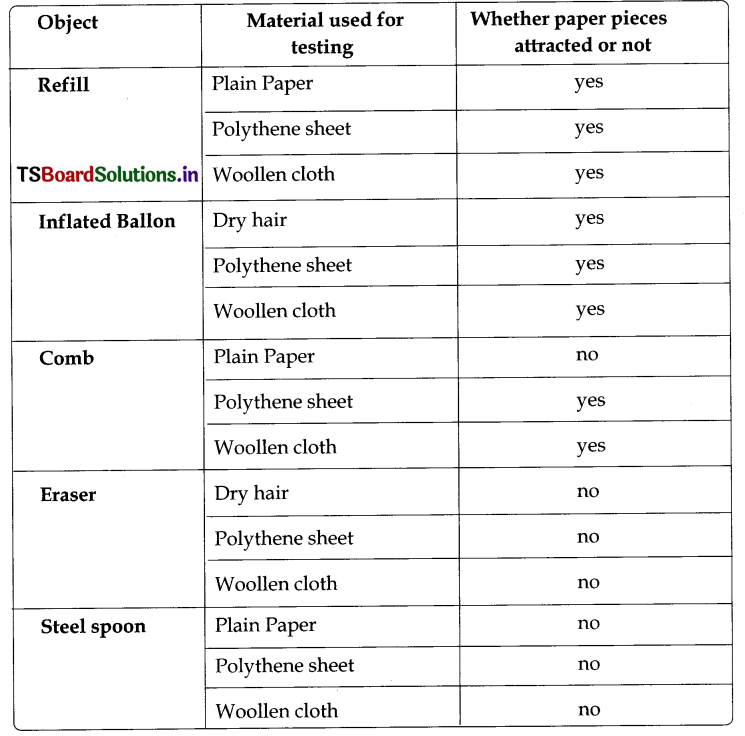
We conclude from the above table.
- Some objects like refill, comb, etc., when rubbed with some specific materials are able to attract light objects like pieces of paper.
- But some objects like spoon and eraser do not attract pieces of paper even after rubbing.
a. Why don’t some materials not attract pieces of paper even after rubbing? (Text. P. No. 135)
Answer:
- During rubbing, a material loses some electric charges and the other material gains those electric charges. Then the two materials acquire opposite charges. Then the two materials become charged bodies.
- The charged body, when brought nearer to pieces of paper, induces an opposite charge in those pieces of paper. Then the charged body attracts those pieces of paper, bearing an opposite charge.
- During rubbing, some materials do not lose (or gain) eletric charges. Such materials can not be charged by rubbing. They remain electrically neutral, even after rubbing. So they cannot attract pieces of paper.
